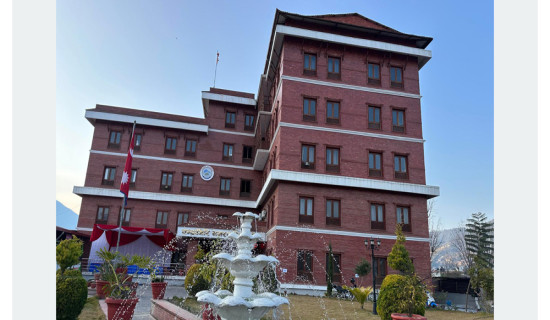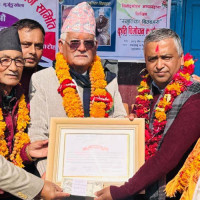- Monday, 29 December 2025
Recurrent GLOFs call for concrete measures to minimise damage
Kathmandu, July 20: An unforeseen flash flood in Rasuwa on July 7, 2025, killed seven people, while 19 others remain missing. The devastating flood occurred without any recorded heavy rainfall and was caused by the sudden drainage of a supraglacial lake located around 36 kilometres north of the Nepal-China border at Rasuwagadhi.
The flood destroyed hydropower plants generating 30 megawatts of energy, swept away the Miteri bridge that connects Nepal and China, and disrupted cross-border trade.
On the same day, July 7, a similar flood struck Upper Mustang, near Chumjung village in Lomanthang Rural Municipality-4. This incident is also suspected to have been triggered by a glacial lake outburst.
Similarly, on May 15, 2025, a glacial lake outburst flood (GLOF) struck the village of Til in the Limi Valley, located in the remote Humla district. GLOF resulted in the loss of infrastructure, including the drinking water source, a recently constructed hydropower plant, and 25 agricultural fields.
On August 16, 2024, a GLOF occurred in the Thame Valley of Solukhumbu District, Nepal. The flood was triggered by the sudden breach of the Ngozumpa Glacial Lake, one of the largest in the region. The outburst unleashed a powerful surge of water and debris down the valley, affecting villages along the Bhotekoshi River.
More than 200 households were impacted, and 20 houses, as well as schools and health clinics, sustained damage. The flood also severely affected trekking routes and disrupted key biodiversity corridors.
Earlier, on April 21, 2024, a sudden flood occurred from Birendra Lake, a glacial lake located at the foot of the Manaslu Glacier in Samagaun, Gorkha District. The flood is believed to have been caused by the sudden inflow of water from an icefall or avalanche, leading to an overflow or breach of the lake’s moraine dam.
On August 13, 2023, intense rainfall triggered destructive flash floods in Kagbeni village, Upper Mustang. The flood of water and debris cascaded down the hillsides, severely damaging the ancient trans-Himalayan settlement and displacing many residents.
Of late, the spike in GLOF incidents highlights the country’s growing vulnerability to the impacts of climate change. Rising temperatures are accelerating glacier melting in the Himalayas, increasing the risk of such disasters. Communities living downstream and remote areas are facing increasing fear and uncertainty, as these sudden and devastating floods threaten their homes, livelihoods and safety.
Increasing GLOF risk
Current records indicate that there are considerable number of glacial lakes in the country. According to the most recent ICIMOD/UNDP report published in 2020, there are 2,070 lakes identified within the country's major river basins.
Out of 47 potentially dangerous glacial lakes (PDGLs) identified across the Hindu Kush Himalayan region, 21 are located within Nepal. This report also said that the number of such risky lakes in the country has doubled over the last decade (2011 to 2020).
“The recent ratio of GLOF events in the country shows the threat is growing in the country,” said Arun Bhakta Shrestha, a senior climate change specialist.
“GLOFs occurring in recent years show that the region is highly vulnerable to the impacts of climate change. Hazards related to the high-altitude cryosphere are on the rise,” he said.
“In the past, we focused only on large glacial lakes and labelled them as potentially dangerous. But now, even smaller lakes -- some of which were never on the risk list -- have started to burst. Therefore, detailed mapping using satellite imagery is essential, as manual mapping is no longer feasible,” said Shrestha.
Dr. Basanta Raj Adhikari, geologist and assistant professor at Tribhuvan University, and director of the Centre for Disaster Studies, said that in the past, only major glacial lake outburst events were recorded due to limited communication and information technology. “Outbursts like the one in Limi, Humla, were often not documented and smaller ones were generally listed only as regular floods,” he said.
“We used to believe that only large lake bursts could have significant downstream impacts. But in recent years, even small lakes have started to form and burst, causing the damage. With advancements in information technology, these smaller events are now being recorded as well,” Adhikari explained.
This trend, he said, showed that such events are accelerating, and smaller lakes also need to be mapped and monitored. “We cannot determine the exact rise in temperature in high-altitude regions due to a lack of ground-based weather stations. However, global projections indicate that temperatures are increasing in the Himalayas, which contributes to the formation and expansion of glacial lakes,” he added.
According to Rijan Bhakta Kayastha, a glaciologist and Professor at the Department of Environmental Science and Engineering at Kathmandu University's School of Science, the only way to address the issue is to reduce temperature rise. He stressed the importance of adhering to the Paris Agreement, which aims to keep the global temperature increase below 1.5 degrees Celsius compared to pre-industrial levels.
A 2025 study by Wilhelm Furian from and Tobias Sauter from Climatology Lab, Geography Department, Humboldt-Universität zu Berlin, Berlin, Germany, titled “Assessing Economic Impacts of Future GLOFs in Nepal's Everest Region Under Different SSP Scenarios Using Three-Dimensional Simulations” explored how GLOFs from five lakes in Sagarmatha region might change things throughout this century.
The study uses advanced 3D modelling (OpenFOAM) to simulate PGLOFs from five lakes in Sagarmatha region. It examined various breach and climate scenarios, showing that even low-magnitude GLOFs can inundate farmland, roads and buildings over distances of up to 84 kilometres.
In severe cases, floods may extend over 100 kilometres, affecting thousands of homes and major infrastructure.
Another research done by Sunil Adhikary, Dhiraj Pradhananga, and Suresh Marahatta on "Glacial Lake Outburst Floods (GLOFs) in the Nepal Himalayas: Recent events, urgent response, and global actions for cryospheric science” also said that the frequency and severity of GLOFs has increased in the country. The research focused on three major recent events -- Birendra Lake, Thame and Limi Valley -- highlighted the growing risks to mountain communities and ecosystems.
Another recent study published in the International Journal of Disaster Risk Reduction, titled “Quantitative assessment of the GLOF risk along China-Nepal transboundary basins,” also highlighted the country’s vulnerability to GLOFs, especially under a worst-case 100 per cent dam break scenario.
The research was conducted jointly by Manish Raj Gouli of Chinese Academy of Sciences, Haiheng Hu of Institute of Mountain Hazards and Environment, Chinese Academy of Sciences, Nitesh Khadka of Institute of Mountain Hazards and Environment, Chinese Academy of Sciences and Shuang Liu of Chinese Academy of Sciences (Chengdu) and others.
The research also warned that such an event could damage or inundate nearly 3,000 buildings, around 50 motorable bridges and nine hydropower plants. Bhotekoshi and Bahrabise are identified as ‘Very High’ risk zones, while Sunkoshi, Tripurasundari, Sangachok Gadhi and Gosaikunda are at ‘High’ risk.
Policy frameworks and international cooperation
Dr. Maheshwor Dhakal, head of the Climate Section at the Ministry of Forests and Environment, said that the government lacks the capacity to monitor and map GLOFs effectively. “We know glaciers are melting and lakes are forming, but there has been no comprehensive study, apart from some satellite mapping,” he said. Most data currently in use comes from studies conducted by UNDP and ICIMOD five years ago.
While policies and Nepal’s Nationally Determined Contributions (NDC) acknowledge the risks, long-term and continuous research remains lacking. “Research should involve setting up monitoring plots from east to west and analysing decades of data, as the situation is unpredictable -- lakes can burst at any time,” said Dhakal.
He stressed the urgent need for detailed mapping, early warning systems in river basins and the development of climate-resilient infrastructure to safeguard vulnerable communities.
He also said that recently, the Green Climate Fund (GCF) has approved a US $36.1 million grant to help the country reduce the risks from GLOFs. The project implementation body UNDP said that the project will support lake lowering, ecosystem-based mitigation, and early warning systems to boost resilience. It also aims to directly benefit around 386,000 people and indirectly impact nearly 2 million.
What needs to be done
“We need to change our approach and conduct detailed studies on how glacial lakes are forming and how their courses are shifting,” said Shrestha. “An early warning system should be installed in the catchment areas. While we cannot stop the glaciers from melting, we can at least alert downstream communities in time to save lives and property.”
“There should also be bilateral negotiations to establish a cross-border early warning system, especially after the recent Rasuwa flood, which taught us that floods can originate from the other side of the border without warning. The discourse on loss and damage must move forward, as adaptation and mitigation alone are no longer enough,” he added.
Adhikari stressed the need for detailed mapping and flood modelling to understand how outburst floods can impact downstream communities. “Local governments should be trained. There should be early warning systems,” he said. “The government must also prioritise bilateral discussions to enhance cross-border cooperation and preparedness.”
In this alarming situation, the United Nations has also declared 2025 as the International Year of Glacier Preservation, marking the start of a decade-long focus until 2034. As Nepal is home to rapidly melting glaciers, this is a vital opportunity and will help to raise global awareness and push for urgent climate action, as glacier loss threatens water sources, livelihoods and ecosystems.
















